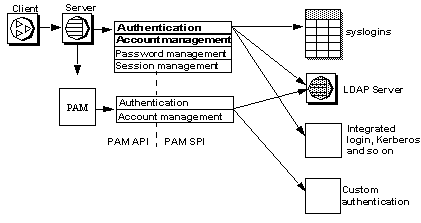Pluggable Authentication Module (PAM) support allows multiple authentication service modules to be stacked and made available without modifying the applications that require authentication.
PAM integrates Adaptive Server with Solaris and Linux operating systems and simplifies the management and administration of user accounts and authentication mechanisms, thus reducing the total cost of ownership. Users can customize or write their own authentication and authorization modules.
![]() PAM support is currently available on Linux and on Solaris
platforms. For more information on PAM user authentication, see
your operating system documentation.
PAM support is currently available on Linux and on Solaris
platforms. For more information on PAM user authentication, see
your operating system documentation.

Adaptive Server passes the login name and credentials obtained from the login packet to the PAM API. PAM loads a service provider module as specified in the operating system configuration files and calls appropriate functions to complete the authentication process.